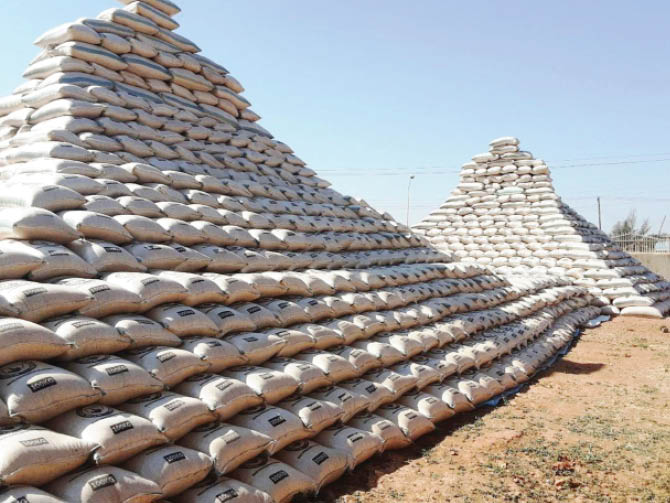2021: Sweet for crop farmers, bitter for their livestock peers, others
Since the COVID-19 lockdown in 2020 smallholder crop farmers had never had it so profitable as they witnessed in the last one year. While they were smiling as the prices of crops hit the roof, their counterparts from the livestock sector saw the worst in decades as feeding their animals became difficult. Many of the […]

Maize pyramid in Funtua
Since the COVID-19 lockdown in 2020 smallholder crop farmers had never had it so profitable as they witnessed in the last one year. While they were smiling as the prices of crops hit the roof, their counterparts from the livestock sector saw the worst in decades as feeding their animals became difficult.
Many of the livestock farmers have since lost their jobs and investments while others are struggling to survive hoping for better days, but going by the current demand-supply curve and the dynamics of production, it is far from over.
Mr Musa Yohana, a smallholder farmer in Nasarawa State, had never got money like he did in 2021. He cultivated sesame, maize, groundnut, rice and yam.
According to him, he got four bags of 110kg of sesame, 21 bags of groundnut, 29 bags of paddy rice, nine bags of maize, three bags of sorghum and 450 tubers of yam, and that with the current prices of the commodities life is better for him and his family.
Sesame now sells for N58,000 per bag, maize costs N23,000, sorghum N24,000, groundnut (unshelled) is N23,500, while rice is N22,000. If Mr Yohana sells everything, he will realise over N1m; something he had thought was not possible.
The 37-year-old father of three said God had decided to wipe away his tears this year, as he has bought a Bajaj motorcycle at the cost of N380,000 for Okada business during the dry season because they do not have irrigation facilities in his village.
Like Mr Yohana, many crop farmers had it better in the 2021 cropping season even though the cost of production was high.
On the other hand, livestock farmers have been in a difficult situation since April, 2020, when the lockdown was implemented, triggering a sudden rise in the prices of grains and other production ingredients. It got worse during the 2021 season, particularly for many smallholder and medium scale farmers who have low capacity to produce feeds.
Many farmers, particularly poultry farmers, have continued to grapple with the cost of inputs, and many said they did not make profit and were struggling to keep the business going.
The cost of feeds and supplements of top brands like Ultima Feed, New Hope Feed, Chikun Feed, Top Feed, Animal Care Feed, Hybrid Feed, Vital Feed and other livestock feeds have gone up from N2,700 to between N6,200 and N8,400 per 25kg; depending on brand, availability and location.
A smallholder poultry farmer, Mr Austin Ben, said, “Chicken and other animals are living things; you must feed them well otherwise you can’t get any good result. But the reality is that the price of their feed does not make keeping them profitable again. You will look at their drugs and other things. Those who are still in it are doing so because farming has become part of them and they cannot leave it. Maybe the big players who have the money have a different experience. But to be honest, small people like us hardly make anything worth the effort.”
Besides livestock farmers, consumers and other value chain actors like those using wheat, maize and soybeans struggled to stay in business because of the rising cost curve of the grains. Even crops like cassava witnessed huge price increase never witnessed in the country before.
